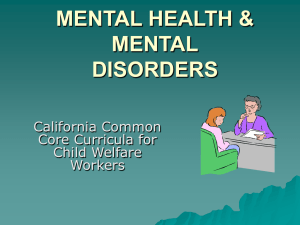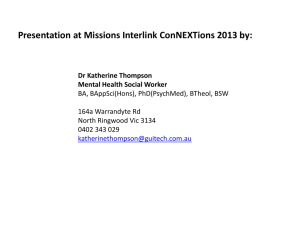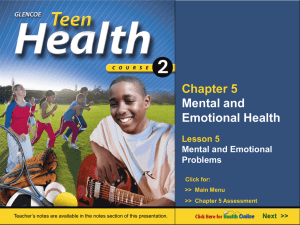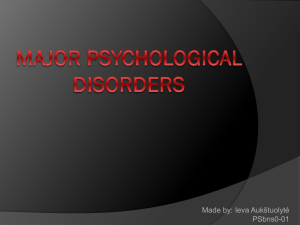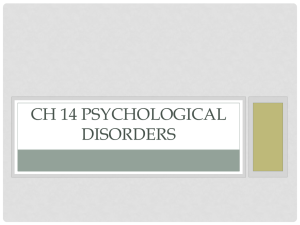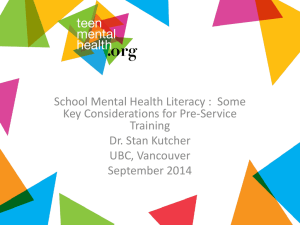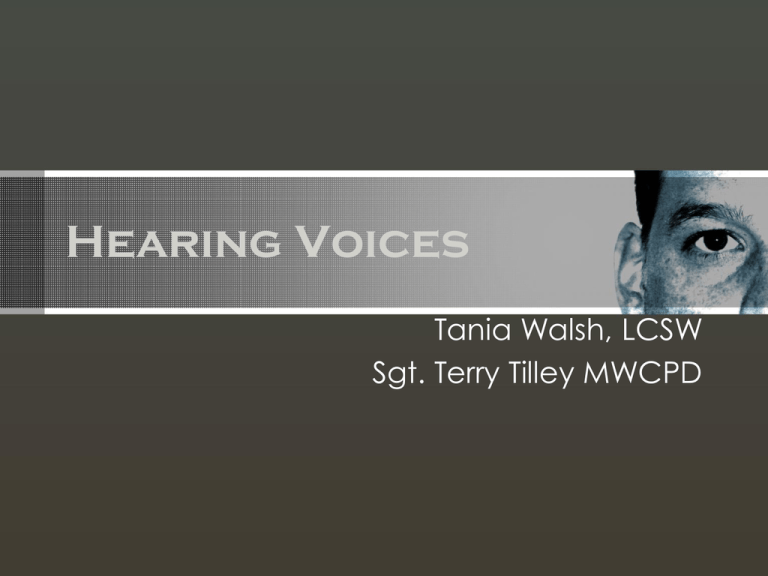
Hearing Voices
Tania Walsh, LCSW
Sgt. Terry Tilley MWCPD
Learning Goals:
• Understanding the day to day
challenges
• Learning about the subjective
experience of hearing voices
• Becoming more empathic
• Changing some of the things we
do to address needs of people
who hear voices
• Identify the impact of severe
emotional disturbance on young
people
Overview
• The simulation experience
–
–
–
–
Word search
Reading comprehension
Crossword
Report interview
GOAL:
The key is to be moving through the
real world to perform tasks while
experiencing the distressing voices
Rules
•
•
•
•
•
•
Do not talk to each other
Keep busy
Just be yourself
Do not leave the facility
Do not change the volume
Do not stop the tape until I tell you
the simulation is over.
• Take care of yourself and if you
need to, turn the MP3 player off.
Push start now
Development of audiotape
• Patricia E. Deegan, PHD.
– Director of Training for the
National Empowerment Center
and an experienced voice
hearer.
• Sampler of voice hearing
• Professional recording studio
– Two females and one male who
also hear voices
Experience and Questions
Discussion
• How did you feel emotionally?
• How did you feel physically?
• Heartbeat?
• How long was the simulation?
Now that you have had this
experience, what will you do
differently in your work with
people who hear distressing
voices?
Youth Experiencing Sever
Emotional Disturbance
Learning Goals:
• Understanding the day to day
challenges young people face
with severe emotional disturbance
• Becoming more empathic
• Changing the way we engage
and address the needs of young
people experiencing signs and
symptoms of mental illness
• Identify the impact of severe
emotional disturbance on young
people
Cultural Perspective
•
“Understanding the cultural dynamics of youth in behavioral
health crisis"
OJA/DHS
Case
Worker
Family
Dynamics
Brain
Development
Dynamics
Youth
Poverty
Dynamics
History of
Trauma
Dynamics
Mental Health
Substance
Abuse
Dynamics
Brain Research Findings
The brain continues to develop during
adolescence.
Areas under construction:
• Prefrontal cortex – responsible for organizing,
setting priorities, strategizing, controlling
impulses
• Brain functions that help plan and adapt to
the social environment
• Brain functions that help put situations into
context; retrieve memories to connect with
gut reactions
Because…
Their Brains
are being
Re-Wired
The Developing Brain, Adolescence and
Vulnerability to Drug Abuse
Risk Taking Behavior?
It is normal! -
Exploration of new
behaviors, decision
making skills,
identity
development
But there is concern –
Adolescents
overestimate their
capacities, rely on their
immature ability to
judge, or give in to peer
pressure
Sensation-seeking Declines with
Age
Risk Perception Declines and Then
Increases After Mid-Adolescence
Self Harm vs. Harm to Others
Self Harmful Behavior
Examples of self harmful
behavior
1. Banging head rapidly and
repeated
2. Running into traffic (with the intent to harm
self)
3. Suicide attempt
4. Actions of self mutilation and
disfigurement
Self Harmful Behavior
Key things to remember
1.
2.
3.
4.
Acknowledge the youth’s distress.
Active listening without interruption.
Ask open-ended questions.
Ask less direct question to start:
A. Have you been unhappy
lately?
B. Have you been very unhappy lately?
4. Ask more direct questions as communication
builds:
A. Have you ever wanted to hurt yourself?
Intentional Harm to Others
Example of intentional harm to others
1. A detailed plan to
intentionally harm family
members, neighbors and/or
animals with weapons or
objects.
http://www.youtube.com/watch?v=H55Oz92KhA&feature=results_main&playnext=1&list=PL9F0592A142852ED2
http://www.youtube.com/watch?v=ME2wmFunCjU&feature=mfu_in_order&list=UL
Functional and Problem Solving Scales
• Things to consider
when
investigating a
youth’s functional
and/or problem
solving ability.
Functional
Ability
Problem
Solving
Behavioral
Health
• Functional Questions
1. Is the young person getting along with friends
2. Is the young person getting along with family
3. Is the the young person able to care for
themselves (taking medicines or brushing teeth)
4. Is the young person controlling emotions and
staying out of trouble
5. Is the young person feeling good about oneself
6. Is the young person thinking clearly and making
good decisions
7. Is the young person able to concentrate, pay
attention, and completing tasks
• Problem Solving Questions
1. Is the young person arguing with others and threaten to
murder an individual
2. Is the young person getting into fights and threaten
individuals with a weapons
3. Is the young person yelling, swearing, or screaming at
others erratically
4. Is the young person displaying fits of anger and
aggressive behavior that’s unprovoked and
unpredictable
5. Is the young person causing trouble for no reason
6. Is the young person using drugs or alcohol
7. Is the young person a repeat offender of breaking rules
or breaking the law (out past curfew, stealing)
Common Behavioral
Health Challenges for
Youth and Young People
OPPOSITIONAL DEFIANT
DISORDER
ADJUSTMENT DISORDER
ATTENTION DEFICIT/
HYPERACTIVITY DISORDER
(ADHD)
MAJOR DEPRESSION DISORDER
CONDUCT DISORDER
ANXIETY DISORDER
OBSESSIVE COMPULSIVE
DISORDER
BIPOLAR DISORDER
BORDERLINE PERSONALITY
DISORDER (BPD)
SCHIZOPHRENIA
SAMHSA National Survey
Any Mental Illness in the Past Year Among Adults (18+),
By Age and Gender
Percent with Serious Mental Illness (SMI) in the Past Year
8
7.3
7
5.9
6
5
6.4
4.8
4
2.8
3
3.2
2
1
0
18 or
Younger
18 to 25
26 to 49
Age Group
50 or
Older
Male
Female
Gender
SAMHSA National Survey
Any Mental Illness in the Past Year Among Adults (18+),
By Age and Gender
Percent with Any Mental Illness in the Past Year (2009)
32
30.0
28
24
20
23.8
22.3
19.9
16
13.7
15.6
12
8
4
0
18 or
Younger
18 to 25
26 to 49
Age Group
50 or
Older
Male
Female
Gender
MENTAL
HEALTH
DISORDERS
SYMPTOMS/
BEHAVIORS
ASSOCIATED ISSUES
OR CHARTERISTICS
OPPOSITIONAL
DEFIANT DISORDER
(ODD)
Difficulty or conflict
with other people;
Disobedient;
Lose temper;
Argue with adults;
Refuse to follow rules;
Annoy others;
Blame others for their
mistakes,
Angry.
Consistently in conflict with
others.
Need to be evaluated for possible
learning disabilities.
MENTAL
HEALTH
DISORDERS
SYMPTOMS/
BEHAVIORS
ASSOCIATED ISSUES
OR CHARTERISTICS
ADJUSTMENT
DISORDER
(AD)
Reduced productivity –
decline in school
performance.
Somatic complaints –
headaches,
stomachaches.
Social maladaptationtruancy, violations of the
rights of others,
destruction of property.
They occur equally in males and
females.
Reaction to the stressor seems to
be in excess of a normal reaction.
Adolescent symptoms of
adjustment disorders are more
behavioral such as acting out.
Associated with higher risk of
attempted as well as completed
suicide.
MENTAL
HEALTH
DISORDERS
SYMPTOMS/
BEHAVIORS
ASSOCIATED
ISSUES OR
CHARTERISTICS
ATTENTION DEFICIT/
HYPERACTIVITY
DISORDER
(ADHD)
TWO CORE CATEGORIES:
1. Inattention (difficulties in
sustaining attention, listening,
following instructions, attending to
details, forgetfulness, impaired
organization, and
It’s a developmental failure in
brain circuitry; typically
diagnosed in school years.
Features of motor activity may
diminish in late
adolescence/early adulthood.
Consistently found more often
in males.
Co-occurring associated with
CD or Bipolar disorder predicts
substance use in adolescence.
Focus on immediate over
delayed gratification may
increase substance use risk.
2. Hyperactivity/ impulsivity
(squirming or fidgeting, running &
climbing excessively, difficulty in
playing quietly, talking excessively.
MENTAL
HEALTH
DISORDERS
SYMPTOMS/
BEHAVIORS
ASSOCIATED
ISSUES OR
CHARTERISTICS
MAJOR DEPRESSION
(MD)
Sad or irritable mood;
Changes in sleep, appetite, or
body movement;
Not interested in previous
activities;
Guilt or worthlessness;
Decreased energy;
Frequent thoughts of death or
suicide;
Difficulty in concentrating;
Feeling like things are too much
trouble or effort.
Rates of death by suicide,
especially in early
adolescence (ages 10-14) have
increased in recent years.
Lesbian and gay youth
thought to be 2-6 times more
likely to make a suicide
attempt than other youth.
Substance use may occur as
an attempt to reduce or modify
symptom experience or may
be associated with peer group
influences.
MENTAL
SYMPTOMS/ ASSOCIATED
HEALTH
BEHAVIORS ISSUES OR
DISORDERS
CHARTERISTICS
CONDUCT
DISORDERS
(CD)
Aggression to people
or animals;
Destruction of
property;
Lying & theft;
Serious rule
violations;
Bullying or
intimidation;
Initiation of fights;
Tend to be loners.
Childhood onset (before age 10)
have more aggression, family
history of anti-social behavior,
early temperamental difficulties.
In males, more evidence of direct
behaviors; in females, more
relational or ‘indirect’ forms may
be observed.
Strong association with
development of substance use
disorders in adolescence.
MENTAL
HEALTH
DISORDERS
SYMPTOMS/
BEHAVIORS
ASSOCIATED
ISSUES OR
CHARTERISTICS
ANXIETY DOSORDER
Excessive fear;
Worry about things before
they happen;
Uneasiness that
interferes with their daily
Lives;
Physical complaints;
Inability to relax;
Lack of concentration;
Frequent stomach aches,
headaches, or other physical
complaints;
Irritability.
Found to frequently run in
families.
Can dramatically reduce
productivity and
significantly diminish an
individual's quality of life.
MENTAL
HEALTH
DISORDERS
SYMPTOMS/
BEHAVIORS
OBSESSIVE
COMPULSIVE
DISORDER
(OCD)
Recurrent, unwanted thoughts
(obsessions)
or
rituals (compulsions), which
adolescents feel they cannot
control.
EX: hand washing, counting,
checking, or cleaning.
ASSOCIATED
ISSUES OR
CHARTERISTICS
OCD is often a chronic,
relapsing illness.
Begins in adolescence or
early childhood.
OCD is sometimes
accompanied by depression,
eating disorders, SA, ADHD,
or other anxiety disorders.
Adolescents may often feel
shame and embarrassment
about their OCD & fear it
means they’re crazy.
Hesitant to talk about their
thoughts or behaviors.
MENTAL
HEALTH
DISORDERS
SYMPTOMS/
BEHAVIORS
ASSOCIATED
ISSUES OR
CHARTERISTICS
BIPOLAR DISORDER
Cycling of manic and
depressive episodes.
Manic symptoms include:
Irritability & agitation;
Sleep disturbance;
Distractibility / impaired
concentration;
Grandiosity;
Reckless behavior;
Suicidal thoughts.
Presentation in youth may be
characterized by ‘very rapid,
brief, recurrent episodes
lasting hours to a few days;
Early onset appears to have
greater frequency in males;
Stronger association with cooccurring SA, anxiety and CD
than with bipolar depression.
MENTAL
HEALTH
DISORDERS
BORDERLINE
PERSONALITY
DISORDER
(BPD)
SYMPTOMS/
BEHAVIORS
Intense anger;
Persistent feelings of emptiness;
Fears of abandonment; Always
seem to be in a crisis;
Disturbed thinking patterns;
Tend to be rational & calm one
moment, & then explode into
inappropriate anger;
Persistent unstable self-image;
Self-damaging Impulsivity
(spending, sex, binge eating);
Repeated suicidal behavior;
Self-mutilation.
ASSOCIATED
ISSUES OR
CHARTERISTICS
Unstable personal relationships.
BPD should be made with great
care to this population due to
personality of adolescents is still
developing.
Occurs in all races.
Prevalent in females.
Typically presents by late
adolescence.
A combination of disruptive
behavioral problems, mood &
anxiety symptoms, and cognitive
symptoms.
MENTAL
HEALTH
DISORDERS
SYMPTOMS/
BEHAVIORS
ASSOCIATED
ISSUES OR
CHARTERISTICS
SCHIZOPHRENIA
Little range of emotions; Few
facial expressions; Poor eye
contact;
Delays in language,
Unusual motor behaviors;
Odd speech, both in content
and tone;
May hear voices, ‘see’
things, problems with
abstraction;
May demonstrate confusion,
suspicion, paranoia;
Unusual fears.
Onset of full disorder
before 6-7.
Difficulty in school
functioning may be an
early sign.
Substance use may
facilitate otherwise
impaired peer group
interaction.
May have few friends or be
withdrawn from peers.
Strategies to Communicate with
Youth
Mental Health Response vs.
Criminal Arrest
• If crime, but no mental illness = Arrest
• If mental illness, but no crime =
Diversion
• If crime + mental illness, consider:
1.
2.
3.
4.
5.
Seriousness of crime
Lethality of risk to self or others
Capability of jail/lockup to manage/treat person
Mental health history
Availability of services
Thank you for Participating
Questions?
• Contact Information
Tania Walsh, LCSW
trubiorosas@odmhsas.org
Sgt. Terry Tilley MWCPD
opie3232@gmail.com
Marqus Butler MHR
mbutler@odmhsas.org




